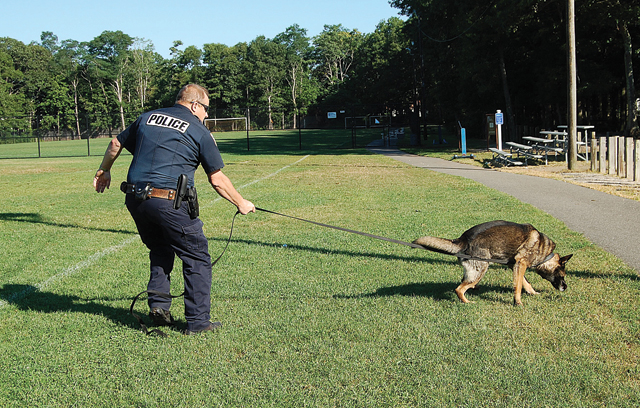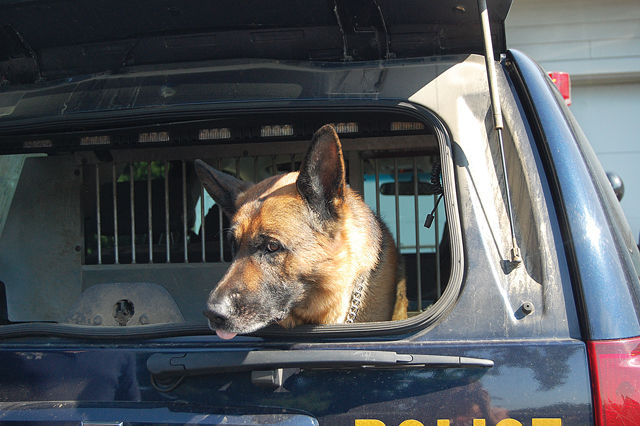These local dogs help our cops in ways a human never could

In a garage connected to the back of the state police barracks in Riverside, O’Neill gets to work immediately.
The police K-9 dog searches in a rear corner of the space and finds the bag of drugs in less than a minute. He is then rewarded with a toy by his handler, Trooper Kevin Drew.
A narcotics dog, O’Neill is one of five police dogs currently working on the North Fork. Gleason, an explosives dog, is also at the trooper headquarters in Riverside. The Riverhead Town Police Department has two narcotics dogs, Vaki and Rocky, and the Southold Town Police Department has one, Hudzin.
“Probably the proudest and best thing is when you go through all this training and then your dog actually does good, like finding people and finding articles on the street,” said Officer Frank Mele of the Southold police.
The dogs, all German shepherds, go through extensive training before they’re able to make their handlers proud. Before being selected by a local police department, the dogs are obtained by the county from a vendor that has purchased them from places like Germany, Poland, Hungary and the Czech Republic. The dogs are then brought to the Suffolk County Police Department training center in Yaphank, where they are tested to see how they behave in certain situations they’ll encounter on the force.
According to Mr. Mele, a K-9 officer since 2004, if the county is looking to purchase three dogs, the vendor might bring five or six for testing. From there, local departments select their dogs and pair the animals with handlers. The partners then participate in a training program that lasts between 16 and 20 weeks.
Dogs that are a part of the Suffolk County Police Department program are trained in apprehension, tracking and evidence searching. New York State police dogs participate in a similar program in Cooperstown, N.Y.
County police dogs, such as those that work with the Riverhead and Southold departments, are required to continue training once a week and must be recertified in their specialty annually. State police dogs attend training twice a month and must be recertified twice a year.
All three departments begin training the dogs when they’re one or two years old so they can get the maximum value from each one. Police dogs have an active career span of approximately eight years.
“The best way to describe a German shepherd, this breed, they’re task-oriented dogs,” Mr. Drew said. “They’re always looking for the next thing to do so that’s what makes them good police dogs.”
Currently, the dogs at all three departments are male.
“A female dog tends to bond more with the handler and sometimes in a building search that doesn’t work,” Mr. Mele said. “We want the independence [males have].”
Mr. Drew, who was partnered with a female dog before O’Neill, didn’t see any disadvantages to using females.
“Originally, when I started, we never used any female dogs,” he said. “Our old K-9 sergeant believed male dogs had a little more drive, but then we tried some female dogs and we realized the female dogs worked just as well.”
After the training is complete, dogs begin working the street. Once they complete a year of only patrol work, the dogs and their handlers receive further training in a specialty, which takes approximately 12 more weeks.

Most police dogs are narcotics dogs, trained to locate “all advanced narcotics,” according to Riverhead Town police K-9 officer John Doscinski. These include marijuana, heroin, cocaine and crack cocaine, LSD, methadone and ecstasy.
Although pills aren’t on the list, Mr. Drew explained that because heroin and pills like oxycodone both contain opiates, K-9 dogs are usually able to locate tablets as well.
“They recognize it by odor,” said Mr. Doscinski, a K-9 officer since 1996. “They’re all trained now in passive alert. The dog will indicate with a nose bump instead of touching or mouthing [the findings] because some of the drugs, if the dog were to bite into them, would kill the dog before you could even get an injection into him.”
State narcotics dogs use an aggressive alert, meaning they dig and are active around their findings. All departments carry Narcan kits in case a dog accidently ingests any drugs.
Gleason, the state’s narcotics dog, is trained in up to 15 scents, including gunpowder, dynamite and TNT.
“Originally when [the K-9 program] started it was only narcotics for Long Island,” Mr. Drew said. “After 9/11 they wanted to know if I wanted to become an explosives dog handler, but I remained in narcotics and we started training explosives dogs — bomb dogs — shortly thereafter. We finally got a bomb dog here a few years ago [in 2008].”
He said that when he joined the police force in 1995 there were about 28 K-9 dogs working for the state police. Currently there are 85 dogs in the unit.
Although each dog is a member of one police department, they are often called to assist in nearby jurisdictions. On Wednesday morning, Officer John Morris from Riverhead and his dog, Rocky, gave an educational demonstration with Mr. Mele and Hudzin at Floyd Memorial Library in Greenport. Mr. Drew said the state dogs are often called upon by nearby departments, such as Southampton, that don’t have their own K-9 units.
K-9 officers typically work night shifts, when the dogs can be used as “another set of eyes,” aiding in car searches, looking for evidence and tracking people.
“For us, basically, it leaves another officer on the road during our busier hours from seven at night to three in the morning,” said Southold Police Chief Martin Flatley. “He’s there to back up other officers on alarm calls and any kind of burglary calls. Even cars stopped at nighttime, where the driver is suspected of drinking and driving. A lot of times, in DWI cases, the driver will run when the officer stops him, so [the dog] backs up a lot of calls we have in the evenings.”
Mr. Doscinski said the best part of working with K-9s is their ability to show police things they might not be able to see on their own.
“It gives you a seventh sense when you’re out there,” he said. “The dog can show you where a person came from, where they went and what they left behind. It gives you an edge and that’s what I really like about it.”
Top photo: Riverhead Town police officer John Doscinski with one of the department’s two K-9 dogs, Vaki.





